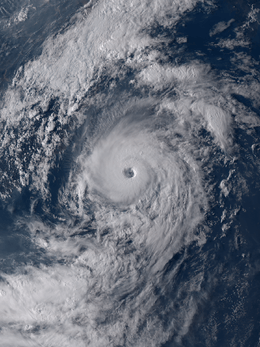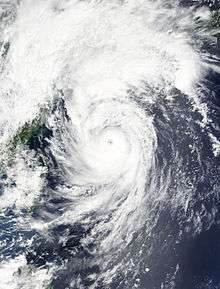Typhoon Goni (2015)
| Typhoon (JMA scale) | |
|---|---|
| Category 4 (Saffir–Simpson scale) | |
 Typhoon Goni hours before peak intensity near Iriomote Island on August 23 | |
| Formed | August 13, 2015 |
| Dissipated | August 30, 2015 |
| (Extratropical after August 25) | |
| Highest winds |
10-minute sustained: 185 km/h (115 mph) 1-minute sustained: 220 km/h (140 mph) |
| Lowest pressure | 930 hPa (mbar); 27.46 inHg |
| Fatalities | 34 confirmed |
| Damage | $293.3 million (2015 USD) |
| Areas affected | Mariana Islands, Philippines, Taiwan, Japan, Korea, China, Russia |
| Part of the 2015 Pacific typhoon season | |
Typhoon Goni, known in the Philippines as Typhoon Ineng, was a powerful tropical cyclone that impacted many countries during late August 2015. The fifteenth named storm of the annual typhoon season, Goni was first seen as a weak tropical disturbance from a cloud cluster several nautical miles east southeast of Guam. The system intensified into a tropical depression on August 13, then a named storm by the next day. Similar to the output of Typhoon Soudelor earlier in the month, Goni impacted the Mariana Islands before gathering strength and intensifying into the ninth typhoon.
Meteorological history

During August 13, the Japan Meteorological Agency reported that a tropical depression, had developed about 685 km (425 mi) to the southeast of Hagåtña, Guam.[1] Behind Goni was another depression. It later became super typhoon Atsani, in which they became the "double-threat" pair of typhoons. By the next day, the depression started to organize and was designated as 16W by the JTWC.[2] Several hours later, deep convection had improved and has covered its LLCC and both agencies upgraded 16W to a tropical storm, naming it Goni.[3][4] During the night of August 15, the JMA upgraded Goni to a severe tropical storm as windshear started to calm whilst deep convective banding wrapping into its circulation.[5][6] By the next day, satellite imagery depicts a developing eye with an improved tightly-curved banding which upper-level analysis reveals that low shear and an improving environment.[7] Goni intensified into a typhoon by both agencies a few hours later.[8][9]
Early on August 17, satellite imagery depicted a small-pinhole eye as Goni underwent rapid intensification and was upgraded rapidly to a Category 4 typhoon and reached its first peak intensity.[10] Slightly thinning convective banding and low to moderate wind shear caused Goni to weaken to a Category 3 typhoon.[11] Goni maintained that intensity while moving westward and entered the Philippine Area of Responsibility which PAGASA gave it the local name Ineng,[12] until on August 19, Goni entered an area of favorable environments. Goni had maintained an overall convective signature with tightly-curved banding wrapping into a 28 nautical-mile eye.[13] The JTWC later re-upgraded Goni back at Category 4 typhoon status early on August 20 as it neared the northeastern Philippine coast. Rapidly weakening soon after, Goni executed a sharp north turn. Then as it turned northeastwards, Goni re-intensified for the third time into a Category 4 typhoon mid-day on August 23.
Typhoon Goni quickly passed through Uki, Kumamoto after 20:00 UTC and made landfall over Arao, Kumamoto after 21:00 UTC on August 24 (06:00 JST on August 25)[14][15] The system arrived in the Sea of Japan as a typhoon early on the next day and weakened into a severe tropical storm at 09:00 UTC.[16] Goni moved northeast then transitioned into extratropical cyclone, as the JTWC and JMA issued their final advisories. Goni's remnants later affected Northeast China and Russia.
Preparations and impact
Mariana Islands
Just nearly two weeks after Soudelor hit the area, the weather service of Guam started to warn residents within the islands to prepare from Tropical Storm Goni. “A lot of the structures that got wiped out by Soudelor, they haven’t had time to rebuild anything yet.” was stated from a forecaster of the National Weather Service of Guam.[17]
Philippines
The PAGASA started issuing advisories on Ineng (Goni) as it entered the Philippine area of Responsibility on August 18.[18] On August 19, PAGASA issued Public Storm Signal #1 and 2 over Batanes and Isabela. The National Disaster Risk Reduction and Management Council was placed on blue alert in preparation for the typhoon.[19] PSWS #3 further raised in those same places on August 20.[20] In nearly the same time, NDRRMC raised from Blue to Red Alert in their area (Under Red Alert status, the NDRRMC continuously monitors and disseminates weather advisories, 24-hour public weather forecasts, gale warnings, and general flood advisories to all regional DRRMCs (RDRRMCs) and Office of Civil Defense regional centers (OCDRCs)). According to the situation report, the Department of Social Welfare and Development (DSWD) has also prepositioned a total of PHP 47,551,086.98 standby funds, 369,199 food packs, and PHP 247,772,538.48 worth of food and non-food items, beginning on August 14, to be utilized in the aftermath of Typhoon Ineng.[21][22] Classes from kinder to high school over in Cagayan province were suspended on August 19.[21][23]
According to the NDRRMC, a total of 33 people are reported dead so far as of September 8, and total damages from both infrastructure and agriculture were amounted to P4.4 billion ($94.3 million USD).[24] But despite reaching the damage cost to PHP 1 billion, the name Ineng was not retired from its naming lists.
Taiwan
Heavy rain hit the capital as the typhoon moved up the coast.
Japan

Five people were injured when Goni passed over Ishigaki Island on August 23.[25] One death has been attributed to high waves as the storm moved towards the mainland. According to NHK, a 66-year-old man drowned after falling from a fishing boat off of Miyazaki Prefecture on the southern island of Kyushu on August 24.[26] Damage to agriculture in Okinawa is estimated at ¥780 million (US$6.5 million).[27] Agriculture damage in Fukuoka Prefecture reached ¥1.6 billion (US$13.3 million).[28] Total damage in Kagoshima Prefecture reached ¥2.1 billion (US$17.5 million).[29] Agricultural, forestry, and fisheries losses in Kumamoto Prefecture amounted to ¥4.1 billion (US$34.1 million).[30] Agricultural losses exceeded ¥600 million (US$5 million) in Oita Prefecture and reached ¥512 million (US$4.3 million) in Saga Prefecture.[31][32]
South Korea
The country went on "alert" on August 25, 2015. There has been no recorded deaths or damages taken. Heavy rain has been observed, an average of 30 millimeters an hour.[33]
Russia
The extratropical remnants of Typhoon Goni brought damaging winds and heavy rains to Primorsky Krai in the Russian Far East. Some areas received more than two months' rain during the storm's passage, resulting in widespread flooding.[34] Approximately 9,500 people were directly affected by the storm, mostly in Ussuriysk. More than 300 buildings sustained damage.[35] Agriculture sustained substantial impact, with 88,300 hectares of crops damaged or destroyed; losses in the sector reached 2.4 billion rubles (US$35.5 million).[34] Total damage from the storm amounted to 8 billion rubles (US$118.3 million).[35]
See also
References
- ↑ "JMA Tropical Cyclone Advisory August 13, 2015 18z". Japan Meteorological Agency. August 13, 2015. Archived from the original on August 14, 2015. Retrieved August 15, 2015.
- ↑ "Tropical Depression 16W (Sixteen) Warning Nr 001". Joint Typhoon Warning Center. August 14, 2015. Archived from the original on August 14, 2015.
- ↑ "Prognostic Reasoning for Tropical Storm 16W (Goni) Warning Nr 04". Joint Typhoon Warning Center. Archived from the original on August 15, 2015. Retrieved August 14, 2015.
- ↑ "TS 1515 GONI (1515) UPGRADED FROM TD". Japan Meteorological Agency. August 14, 2015. Archived from the original on August 15, 2015.
- ↑ "STS 1515 GONI (1515) UPGRADED FROM TS". Japan Meteorological Agency. Archived from the original on August 15, 2015. Retrieved August 15, 2015.
- ↑ "Prognostic Reasoning for Tropical Storm 16W (Goni) Warning Nr 05". Joint Typhoon Warning Center. Archived from the original on August 15, 2015. Retrieved August 15, 2015.
- ↑ "Prognostic Reasoning for Tropical Storm 16W (Goni) Warning Nr 09". Joint Typhoon Warning Center. Archived from the original on August 16, 2015. Retrieved August 16, 2015.
- ↑ "Prognostic Reasoning for Typhoon 16W (Goni) Warning Nr 11". Joint Typhoon Warning Center. Archived from the original on August 16, 2015. Retrieved August 16, 2015.
- ↑ "TY 1515 GONI (1515) UPGRADED FROM STS". Japan Meteorological Agency. Archived from the original on August 16, 2015. Retrieved August 16, 2015.
- ↑ "Prognostic Reasoning for Typhoon 16W (Goni) Warning Nr 13". Joint Typhoon Warning Center. Archived from the original on August 17, 2015. Retrieved August 17, 2015.
- ↑ "Prognostic Reasoning for Typhoon 16W (Goni) Warning Nr 16". Joint Typhoon Warning Center. Archived from the original on August 18, 2015. Retrieved August 17, 2015.
- ↑ "Typhoon 'Ineng' enters PAR". Inquirer.net. August 18, 2015.
- ↑ "Prognostic Reasoning for Typhoon 16W (Goni) Warning Nr 22". Joint Typhoon Warning Center. Archived from the original on August 19, 2015. Retrieved August 19, 2015.
- ↑ "平成27年 台風第15号に関する情報 第104号" (in Japanese). Japan Meteorological Agency. Archived from the original on August 24, 2015. Retrieved August 24, 2015.
- ↑ "平成27年 台風第15号に関する情報 第106号" (in Japanese). Japan Meteorological Agency. Archived from the original on August 25, 2015. Retrieved August 25, 2015.
- ↑ "平成27年 台風第15号に関する情報 第112号" (in Japanese). Japan Meteorological Agency. Archived from the original on August 25, 2015. Retrieved August 25, 2015.
- ↑ "Tropical storms headed toward Saipan as residents recover from typhoon". Global News. August 14, 2015.
- ↑ "Typhoon 'Ineng' enters PAR". Philstar. August 18, 2015.
- ↑ "Storm signals up in northern Luzon areas". Philstar. August 19, 2015.
- ↑ "Signal No. 3 as Ineng brings heavy rains over Luzon". Philstar. August 20, 2015. Retrieved August 21, 2015.
- 1 2 "NDRRMC braces for typhoon Ineng". GMA News. August 20, 2015.
- ↑ "SitRep No.3 re Preparedness Measures and Effects of Typhoon "INENG" (GONI)" (PDF). NDRRMC. August 20, 2015.
- ↑ "SitRep No.2 re Preparedness Measures and Effects of Typhoon "INENG" (GONI)" (PDF). NDRRMC. August 19, 2015.
- ↑ "SitRep No.23 re Preparedness Measures and Effects of Typhoon "INENG" (GONI)" (PDF). NDRRMC. Retrieved September 8, 2015.
- ↑ "Typhoon Goni threatens Japan, kills 26 in Philippines". The Statesman. PTI MAnila. Retrieved 24 August 2015.
- ↑ "Typhoon Goni: 40 Casualties Reported In North Korea as Goni Remnants Cause Flooding". Weather Channel. August 26, 2015.
- ↑ "Typhoon Goni causes damages of 780 million yen to agriculture, fisheries in Okinawa.". Ryukyu Shimpo. Ryukyu Shimpo. Retrieved 3 September 2015.
- ↑ "<台風15号>農林水産業、被害16億2600万円 県が状況まとめ /福岡". 毎日新聞 (in Japanese). September 8, 2015. Retrieved September 9, 2015.
- ↑ "台風15号 県内の農業被害12億円" (in Japanese). Yomiuri Shimbun. September 4, 2015. Retrieved September 9, 2015.
- ↑ "熊本の農林水産業、台風被害41億円超" (in Japanese). 産経ニュース. September 10, 2015. Archived from the original on September 14, 2015. Retrieved September 14, 2015.
- ↑ "台風15号被害総額6億円超える" (in Japanese). 大分放送. September 8, 2015. Archived from the original on September 14, 2015. Retrieved September 14, 2015.
- ↑ "台風15号の県内農産物被害5億円超" (in Japanese). September 11, 2015. Archived from the original on September 14, 2015. Retrieved September 14, 2015.
- ↑ "Heavy downpours pound S. Korea as Typhoon Goni approaches". Yonhap. August 25, 2015. Retrieved 26 August 2015.
- 1 2 "Приморский тайфун оценили в 2,4 млрд рублей" (in Russian). Коммерсант. September 2, 2015. Retrieved September 11, 2015.
- 1 2 "Ущерб от паводка в Уссурийске составил 8 млрд рублей" (in Russian). ПРОНЕДРА. September 6, 2015. Retrieved September 11, 2015.
External links
| Wikimedia Commons has media related to Typhoon Goni (2015). |
- Tropical Cyclone Information of Typhoon Goni (1515) from the Japan Meteorological Agency
- JMA General Information of Typhoon Goni (1515) from Digital Typhoon
- JMA Best Track Data of Typhoon Goni (1515) (Japanese)
- 16W.GONI from the U.S. Naval Research Laboratory
